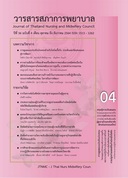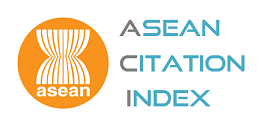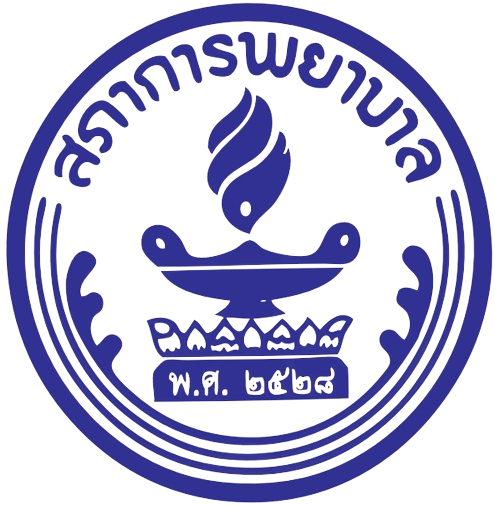ปัจจัยทำนายภาวะทุพโภชนาการของผู้บาดเจ็บที่ได้รับการผ่าตัด
คำสำคัญ:
ความรุนแรงของการบาดเจ็บ, พลังงานที่ได้รับ, ภาวะไข้, ภาวะทุพโภชนาการ, ผู้บาดเจ็บที่ได้รับการผ่าตัดบทคัดย่อ
วัตถุประสงค์การวิจัย: เพื่อศึกษาอำนาจการทำนายของความรุนแรงของการบาดเจ็บพลังงานที่ได้รับใน 72 ชั่วโมงและภาวะไข้หลังการผ่าตัด 72 ชั่วโมง ต่อการเกิดภาวะทุพโภชนาการในผู้บาดเจ็บที่ได้รับการผ่าตัด
การออกแบบวิจัย: การวิจัยหาความสัมพันธ์เชิงทำนาย
การดำเนินการวิจัย: กลุ่มตัวอย่างเป็นผู้บาดเจ็บที่เข้ารับการรักษาในแผนกศัลยกรรมโรงพยาบาลระดับตติยภูมิขั้นสูง จำนวนทั้งสิ้น 137 ราย เก็บข้อมูลโดยใช้แบบบันทึกข้อมูลทั่วไป แบบบันทึกความรุนแรงของการบาดเจ็บ พลังงานที่ได้รับและพลังงานที่ต้องการ อุณหภูมิหลังการผ่าตัด 72 ชั่วโมง แบบบันทึกปริมาณสารน้ำาเข้า-ออก และแบบประเมินภาวะทุพโภชนาการการวิเคราะห์ข้อมูลด้วยสถิติการวิเคราะห์ถดถอยแบบทวิ กำหนดระดับนัยสำคัญที่ระดับ .05
ผลการวิจัย: ผู้บาดเจ็บส่วนใหญ่เป็นเพศชายร้อยละ 70.10 พบภาวะทุพโภชนาการในวันที่ 8 หลังเข้ารับการรักษาร้อยละ 76.60 ความรุนแรงของการบาดเจ็บ ≥ 9 พบร้อยละ 78.80 พลังงานที่ได้รับใน 72 ชั่วโมงหลังผ่าตัดเฉลี่ย 784.32 Kcal ซึ่งไม่ถึงครึ่งหนึ่งของพลังงานที่ต้องการ เฉลี่ยคือ 1,704.36 Kcal ผู้บาดเจ็บมีภาวะไข้หลังผ่าตัดร้อยละ 37.20 ความรุนแรงของการบาดเจ็บ พลังงานที่ได้รับใน 72 ชั่วโมงหลังผ่าตัด และภาวะไข้ สามารถทำนายการเกิดภาวะทุพโภชนาการ ของผู้บาดเจ็บได้ ร้อยละ 31 อย่างมีนัยสำคัญทางสถิติที่ระดับ .01 (Nagelkerke R2= 0.31, p < 0.01)
ข้อเสนอแนะ: พยาบาลควรดูแลโภชนาการของผู้บาดเจ็บหลังผ่าตัด ให้ได้รับพลังงานมากกว่า 50% ของความต้องการแต่ละบุคคล โดยเฉพาะในผู้ที่มีความรุนแรงของการบาดเจ็บตั้งแต่ 9 คะแนนขึ้นไป
Downloads
References
James SL, Abate D, Abate KH, Abay SM, Abbafati C, Abbasi N, et al. Global, regional, and national incidence,
prevalence, and years lived with disability for 354 diseases and injuries for 195 countries and territories, 1990–2017: a systematic analysis for the global burden of disease study 2017. Lancet. 2018;392(10159): 1789-858.
Vosswinkel J, McCormack JE, Thode HC, Singer AJ. Surgical admissions for traumatic injuries: the tip of the iceberg. Ann Emerg Med. 2014;64 Suppl 4:S95.
Dijkink S, Meier K, Krijnen P, Yeh DD, Velmahos GC, Schipper IB. Malnutrition and its effects in severely injured trauma patients. Eur J Trauma Emerg Surg. 2020;46(5):993-1004.
Ljungqvist O, Fearon K. Nutrition in surgery and trauma. In: Elia M, Ljungqvist O, Stratton RJ, New SL, Davies DSC, editors. Clinical Nutrition. 2nd ed. New Jersey: John Wiley & Sons; 2015. p. 350-62.
Pour HA, Van Giersbergen MY. The relationship between fever and haemodynamic parameters in surgical febrile patients: a review. SCIREA J Clin Med. 2016;(1):136-45.
Ihle C, Freude T, Bahrs C, Zehendner E, Braunsberger J, Biesalski HK, et al. Malnutrition–an underestimated
factor in the inpatient treatment of traumatology and orthopedic patients: a prospective evaluation of 1055
patients. Injury. 2017;48(3): 628-36.
Haltmeier T, Inaba K, Schnüriger B, Siboni S, Benjamin E, Lam L, et al. Factors affecting the caloric and protein
intake over time in critically ill trauma patients. J Surg Res. 2018;226:64-71.
Oh CS, Lee JG, Kim SH. Time to Surgery and Injury Severity Score. J Trauma Inj. 2016;29(4): 151-54.
Apple CG, Miller ES, Loftus TJ, Kannan KB, Parvataneni HK, Hagen JE, et al. Impact of injury severity on the inflammatory state and severe anemia. J Surg Res. 2020;248:109-16.
Hsieh CH, Lai WH, Wu SC, Chen YC, Kuo PJ, Hsu SY, et.al. Trauma injury in adult underweight patients: A cross-sectional study based on the trauma registry system of a level I trauma center. Medicine. 2017 Mar;96(10):1-10
Madiai S, Consales A, Gheri CF, Pancani S, Campani F, Biff B, et al. Severe brain injury: does nutrition therapy improve rehabilitation outcomes in terms of bedsores?. Nutrition. 2019;65:6
Berger MM, Reintam-Blaser A, Calder PC, Casaer M, Hiesmayr MJ, Mayer K, et al. Monitoring nutrition in the ICU. Clin Nutr. 2019;38(2):584-93.
Leandro-Merhi VA, Srebernich SM, Gonçalves GMS, de Aquino JL. In-hospital weight loss, prescribed diet and food acceptance. Arq Bras Cir Dig. 2015; 28(1):8-12.
Byerly S, Vasileiou G, Qian S, Mantero A, Lee EE, Parks J, et al. Early hypermetabolism is uncommon in trauma intensive care unit patients. JPEN J Parenter Enteral Nutr. 2020;0:1-11
Kirsch R, Matthews K, Williams V. Using global criteria to detect malnutrition: application in disease states. Nutr Clin Pract. 2020;35(1):85-97.
Maday KR, Hurt JB, Harrelson P, Porterfeld J. Evaluating postoperative fever. JAAPA. 2016; 29(10):23-8. 17. Hinson HE, Rowell S, Morris C, Lin AL, Schreiber MA. Early fever after trauma: does it matter? J Trauma Acute Care Surg. 2018;84(1):19-24.
Mogensen KM, Malone A, Becker P, Cutrell S, Frank L, Gonzales K, et al. Academy of nutrition and dietetics/
American society for parenteral and enteral nutrition consensus malnutrition characteristics: usability and association with outcomes. Nutr Clin Pract. 2019; 34(5)657-65.
de van der Schueren MAE, de Smoker M, Leistra E, Kruizenga HM. The association of weight loss with one-year mortality in hospital patients, stratifed by BMI and FFMI subgroups. Clin Nutr. 2018;37(5): 1518-25.
Shah S, Hollands JM, Pontiggia L, Bingham AL. Impact of the time to initiation of parenteral nutrition on patient outcomes in critically ill adults. Nutr Metab Insights. 2019;12:11786388198 59315.
Lambert C, Nüssler A, Biesalski HK, Freude T, Bahrs C, Ochs G, et al. Age-dependent risk factors for malnutrition in traumatology and orthopedic patients. Nutrition. 2017;37:60-7.
Paladkhua S, Kittiwatanapaisan W. Nutrition in patients with severe head injury. Journal of Nursing and Health Care. 2014;32(1):40-9. (in Thai)
Helander EM, Webb MP, Menard B, Prabhakar A, Helmstetter J, Cornett EM, et al. Metabolic and the surgical stress response considerations to improve postoperative recovery. Curr Pain Headache Rep. 2019;23(5):331-8.
McClave SA, DiBaise JK, Mullin GE, Martindale RG. ACG clinical guideline: nutrition therapy in the adult hospitalized patient. Am J Gastroenterol. 2016;111(3):315-34.
Chakravarty C, Hazarika B, Goswami L, Ramasubban S. Prevalence of malnutrition in a tertiary care hospital in India. Indian J Crit Care Med. 2013; 17(3):170-3.
Baker SP, O’Neill B, Haddon W Jr, Long WB. The injury severity score: a method for describing patients with multiple injuries and evaluating emergency care. J Trauma. 1974;14(3):187-96.
Fleischman RJ, Mann NC, Dai M, Holmes JF, Wang NE, Haukoos J, et al. Validating the use of ICD-9 code mapping to generate injury severity scores. J Trauma Nurs. 2017;24(1):4-14.
Harris JA, Benedict FG. A biometric study of human basal metabolism. Proc Natl Acad Sci U S A. 1918 Dec;4(12):370-3.
Malone A, Hamilton C. The academy of nutrition and dietetics/the American society for parenteral and enteral nutrition consensus malnutrition characteristics: application in practice. Nutr Clin Pract. 2013;28(6): 639-50.
Benyapad P, Thosingha O, Sawawiboon C. The relationships between mechanism of injury systemic inflammatory response syndrome route of nutrition supplement and getting energy requirement in patients with multiple traumas. VNJ. 2015;17: 11-18. (in Thai)
Yandell R, Wang S, Bautz P, Shanks A, O’Connor S, Deane A, et al. A retrospective evaluation of nutrition support in relation to clinical outcomes in critically ill patients with an open abdomen. Aust Crit Care. 2019;32(3):237-42.
Gatuporn S. Nutrition patient critical condition that use the respirator in Phra Nakhon Si Ayutthaya hospital. Journal of Preventive Medicine Association of Thailand. 2014;4(2):135-42. (in Thai)
Mukdaprawat P, Danaidutsadeekul S, Chanruangvanich W, Itthimathin P. Relationships between brain tumor
grading, severity of neurological defcit, nutritional status and functional status in brain tumor patients during hospital stay. J Nurs Sci. 2012;30(3): 46-54. (in Thai)







